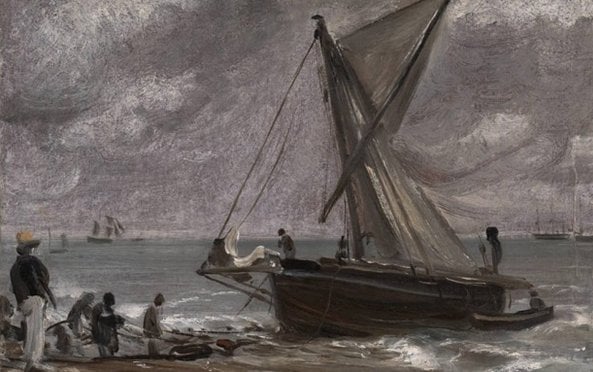
Constable’s Beaching a Boat, Brighton, to be returned to its original Jewish owners
Finding a forgery
Eleanor Head advises galleries on their legal position in the event that a painting turns out to be a forgery or its ‘provenance is tainted’.
Private collector Martin Lang from Leeds was featured recently in the BBC1 series Fake or Fortune?, as he had bought a Chagall painting (Nude: 1909–10) for £100,000. He had hoped it was by the famous expressionist artist Marc Chagall, but happy to accept it as a beautiful painting by an unknown artist in the event that it was not. Fiona Bruce, Philip Mould and Bendor Grovesnor, who appear on the Fake or Fortune? show, subsequently conducted extensive historical and scientific research to try to establish a legitimate provenance for the painting, but were met with disappointment and alarm when the Chagall Committee in France unanimously ruled it was a fake and would be destroyed under an archaic French Law.
Art fraud is not a recent phenomenon. In the 18th and 19th centuries, forgers were often fledgling artists who tried, unsuccessfully, to break into the market and eventually resorted to forgery. Since then, art forgers have become highly sophisticated, using technical methods to recreate famous works of art. Wolfgang Beltracchi, a notorious German art forger, was convicted in 2011 for counterfeiting well-known artists including Heinrich Campendonk, Fernand Léger and Max Ernst, raking in an estimated €34 million in sale profits. Among the authenticity documents he provided, Beltracchi recreated distinctive labels on the back of the canvases using artificially aged paper, and staged a black-and-white photograph of his wife impersonating her grandmother, Josefine Jägers, from whom she claimed she had inherited the paintings.
Tainted provenance has more recently affected institutions holding works of art which were looted from Jewish families by the Nazis
It is clear from the Beltracchi example that art fraud cases are often complex and involve not just one but a string of frauds. There are multiple opportunities for fraud in an art transaction: the production of the picture by the forger, the creation of false authenticity documents (most commonly a certificate of authenticity), money laundering through the purchase of art, and concealment of the tainted provenance of an artwork, to name a few.
Tainted provenance in particular can be problematic for new buyers. Under English law, the usual rule is Nemo dat quod non habet (a thief cannot pass title in goods which he does not own). This, in effect, means that a new buyer not only fails to inherit good title to an artwork, but also risks having to return it to its original owner (which leaves them with a potential claim against the person from whom the art was bought). If the buyer can establish that he has purchased the artwork in good faith, with no knowledge of the theft, the original owner – or his heirs – must bring his claim for restitution within six years of the date of the good faith purchase, after which the claim becomes time barred.1
Consequently, potential purchasers of art should always check the Art Loss Register before making a purchase to avoid buying stolen art and, should it be necessary, provide evidence if they did so that they were acting ‘in good faith’. Tainted provenance has more recently affected institutions holding works of art which were looted from Jewish families by the Nazis during the Second World War, and which are now the subject of restitution claims by their descendants. Very recently, the Tate has been told that it must return an oil painting by John Constable which was stolen from a Hungarian collector by the Nazis between 1944 and 1945. It is the first time the gallery has had to comply with such a request.
Galleries and art collectors should be aware that there are multiple civil and criminal remedies that fraud lawyers can pursue on their behalf against the vendor gallery or dealer responsible, to secure a full recovery. These include actions for fraudulent misrepresentation, conversion or conspiracy to defraud, as well as recovery through asset freezing and tracing. Victims of art fraud often work in tandem with art insurers and private investigators, whose costs may be borne by the fraudulent party in the event of a successful claim.
The historic lack of market regulation and the informal ‘hand-shake’ culture of the art world have allowed people engaging in fraud, be it buyers, sellers, artists, dealers or other agents, to proliferate within the industry. With a Chagall painting fetching over $4 million at auction, an art fraudster has a lot to gain and the old legal adage caveat emptor (buyer beware) has never been more pertinent.
Eleanor Head is an Associate in the Commercial Litigation, Civil Fraud and Asset Recovery Department of Peters & Peters Solicitors LLP.
www.petersandpeters.com
Join the Discussion
You must be logged in to post a comment.